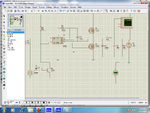zami123
Junior Member level 1
Buck Convertor using IR2103 problems
Hi everyone,i have almost read all the posts realting to the buck convertor but havent got any solution to my problem.I am using IGBT mg300H1UL1 in the convertor.The gate of Igbt is connected to ATmega 16 from which i am generating pwm. I am using IGBT driver Ir2103.But problem is that whenever i put IGBT 300H1U1,the i.c blown.I have made the design of i.c on proteus with mosfets 840 and everything is working fine but replacing with mg300H1Ul1 ,the i.c blow..Any one kindly help me with the problem...????
Hi everyone,i have almost read all the posts realting to the buck convertor but havent got any solution to my problem.I am using IGBT mg300H1UL1 in the convertor.The gate of Igbt is connected to ATmega 16 from which i am generating pwm. I am using IGBT driver Ir2103.But problem is that whenever i put IGBT 300H1U1,the i.c blown.I have made the design of i.c on proteus with mosfets 840 and everything is working fine but replacing with mg300H1Ul1 ,the i.c blow..Any one kindly help me with the problem...????
